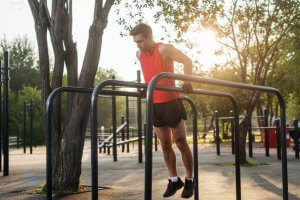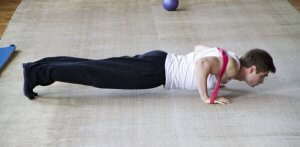How to do a Chest Press and see Good Results

The chest press is one of the most popular exercises for developing strong pecs.
The ideal technique for performing the chest press
Position
Lie on the bench, which will firmly support your back. Make sure you avoid the natural curve in your lower back by pressing your belly button down. This will ensure you don’t have any lower back pain.
Both your feet should be on the floor, bend on the knees in a 90-degree angle. The bar should be right above your forehead, so your arms will go slightly backward.
Read more: Tips for Doing Squats, Deadlifts, and the Bench Press
Grip and lift
When holding the bar, a distance should be left between both index fingers of between 55 and 70 cm. A more open grip limits the elevation and exercises the pectorals and deltoids. On the contrary, a closed grip favors the work of the triceps. Experts advise that you find a middle ground so that the upper musculature develops in a balanced way.
Extend your arms above your head to loosely hold the bar and place your hands. With the shoulders well positioned backward, tighten your grip and lift the bar from the rack. First, you extend your arms at their fullest, locking the elbows. Then, lower the bar to your chest slowly.

Concentration is essential to avoid injury, so it helps if you find a point in the ceiling to look at. The bar should rise to this reference point every time.
Remember, your forearms have to be vertical at all times, holding the bar. By keeping them this way, you prevent your wrists from bending, avoiding injuries.
When descending, the bar should reach an intermediate point between the chest and the sternum. You’ll only be able to achieve this position if you open your elbows wide.
Variations to improve the results of the chest press
An athlete with some experience in doing the chest press might find that the movements aren’t as effective as they were in the beginning. This could mean that you should modify the moves slightly.
If you want a change, you can try placing your hands close to each other, right in the middle of the bar. Then, you do the chest press as you’re used to. This will focus the effort and your pecs will work harder.
You might also enjoy: How to Bench Press Properly
You could also try lifting your upper body slightly every time you lift the weight. Placing the hands in their usual positions and making sure your feet are well placed, proceed to do a regular chest press. Then, at the highest, the bar can go, crunch your abs to lift your shoulders.
Make sure you warm up thoroughly before doing any kind of chest press, as otherwise, it could lead to several injuries. Always keep your feet on the ground, as they give you stability. Of course, never start doing chest presses with a lot of weight. Build your strength, don’t overdo yourself.
Alternative and complementary exercises to the chest press
Crosses with high pulleys
The results of doing crosses are very similar to those of chest press, due to muscle activation. It runs from the top down and ends with a cross-arm at hip height. In each session, you should do 3 sets of 10 repetitions.

Parallel bar dips
Parallel bar dips are a great way to activate your chest muscles. Place a hand over each bar and raise yourself. Crossing your feet at the ankles and with your knees slightly bent, lower your body bending your elbows. We recommend doing 3 series of 10 reps each.

Push-ups with elastic bands
The band is held in both hands, crossing behind your back. This way, when you do the push-up, the resistance increases, making you work even harder. This is a great way to further work your pecs.

Tips to perform the chest press and avoid injuries
For beginners, we recommend you start performing chest presses holding only an elastic band. As you get stronger, you can use empty bars. The idea is to slowly increase weight and avoid injuries due to sudden movements.
Likewise, you should try to train with another person nearby. In case an incident occurs, such as a sudden cramp, the other person can come to your assistance.
The chest press is one of the most popular exercises for developing strong pecs.
The ideal technique for performing the chest press
Position
Lie on the bench, which will firmly support your back. Make sure you avoid the natural curve in your lower back by pressing your belly button down. This will ensure you don’t have any lower back pain.
Both your feet should be on the floor, bend on the knees in a 90-degree angle. The bar should be right above your forehead, so your arms will go slightly backward.
Read more: Tips for Doing Squats, Deadlifts, and the Bench Press
Grip and lift
When holding the bar, a distance should be left between both index fingers of between 55 and 70 cm. A more open grip limits the elevation and exercises the pectorals and deltoids. On the contrary, a closed grip favors the work of the triceps. Experts advise that you find a middle ground so that the upper musculature develops in a balanced way.
Extend your arms above your head to loosely hold the bar and place your hands. With the shoulders well positioned backward, tighten your grip and lift the bar from the rack. First, you extend your arms at their fullest, locking the elbows. Then, lower the bar to your chest slowly.

Concentration is essential to avoid injury, so it helps if you find a point in the ceiling to look at. The bar should rise to this reference point every time.
Remember, your forearms have to be vertical at all times, holding the bar. By keeping them this way, you prevent your wrists from bending, avoiding injuries.
When descending, the bar should reach an intermediate point between the chest and the sternum. You’ll only be able to achieve this position if you open your elbows wide.
Variations to improve the results of the chest press
An athlete with some experience in doing the chest press might find that the movements aren’t as effective as they were in the beginning. This could mean that you should modify the moves slightly.
If you want a change, you can try placing your hands close to each other, right in the middle of the bar. Then, you do the chest press as you’re used to. This will focus the effort and your pecs will work harder.
You might also enjoy: How to Bench Press Properly
You could also try lifting your upper body slightly every time you lift the weight. Placing the hands in their usual positions and making sure your feet are well placed, proceed to do a regular chest press. Then, at the highest, the bar can go, crunch your abs to lift your shoulders.
Make sure you warm up thoroughly before doing any kind of chest press, as otherwise, it could lead to several injuries. Always keep your feet on the ground, as they give you stability. Of course, never start doing chest presses with a lot of weight. Build your strength, don’t overdo yourself.
Alternative and complementary exercises to the chest press
Crosses with high pulleys
The results of doing crosses are very similar to those of chest press, due to muscle activation. It runs from the top down and ends with a cross-arm at hip height. In each session, you should do 3 sets of 10 repetitions.

Parallel bar dips
Parallel bar dips are a great way to activate your chest muscles. Place a hand over each bar and raise yourself. Crossing your feet at the ankles and with your knees slightly bent, lower your body bending your elbows. We recommend doing 3 series of 10 reps each.

Push-ups with elastic bands
The band is held in both hands, crossing behind your back. This way, when you do the push-up, the resistance increases, making you work even harder. This is a great way to further work your pecs.

Tips to perform the chest press and avoid injuries
For beginners, we recommend you start performing chest presses holding only an elastic band. As you get stronger, you can use empty bars. The idea is to slowly increase weight and avoid injuries due to sudden movements.
Likewise, you should try to train with another person nearby. In case an incident occurs, such as a sudden cramp, the other person can come to your assistance.
This text is provided for informational purposes only and does not replace consultation with a professional. If in doubt, consult your specialist.








